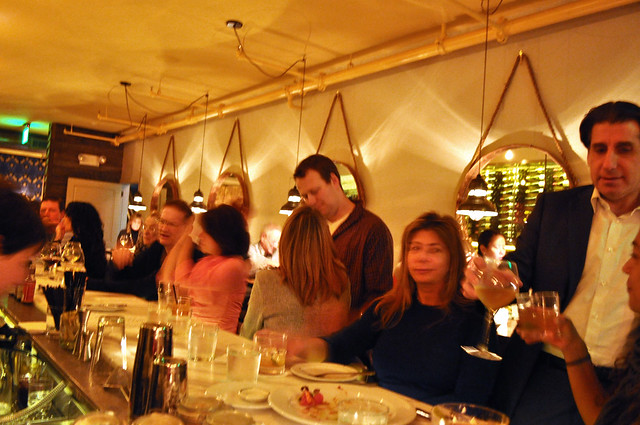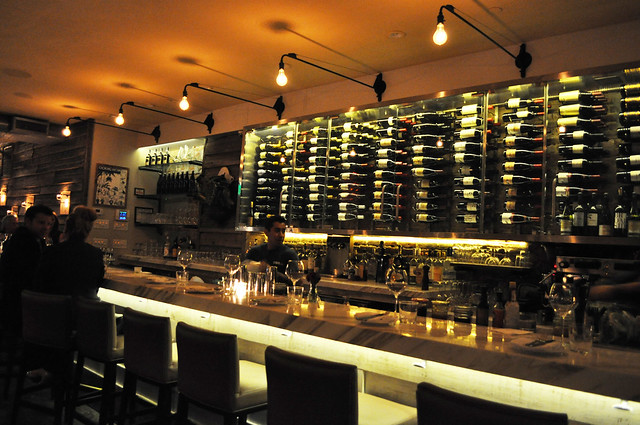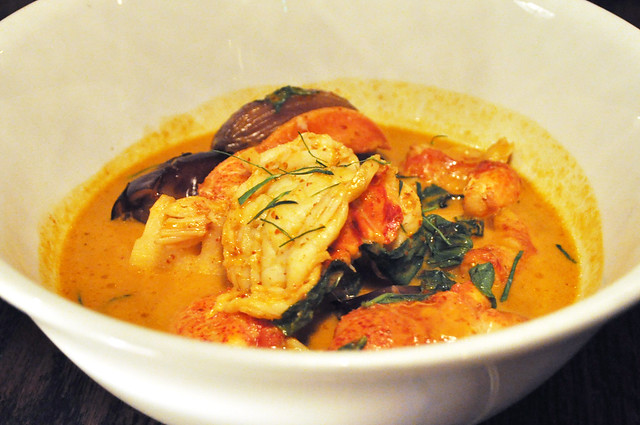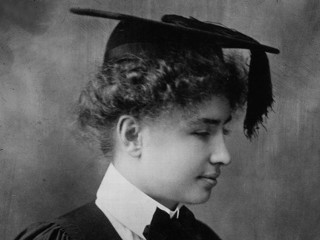This past Thursday, Lisa and I made our way to
Ichimura at Brushtroke, the quasi-hidden sushi bar at Chef David Bouley and Chef Yoshiki Tsuji's Japanese kaiseki cuisine restaurant, Brushstroke. After reading Pete Wells' captivating
three-star review (and essentially the unveiling of the formerly secret sushi haven to the general public) in
The New York Times back in late September, I immediately went to book a reservation before the waves of urban omnivores inundated the seat availability at
Ichimura. A call back then landed me in mid-November late in the evening at 9:30 PM.
I had been to
Brushstroke with Marcus last year (on its opening day, actually), before any sushi made its way onto the menu or any sushi bar, for that matter, so it was nice to finally make it back there and for a completely different experience, too. Lisa and I have been eating our way through the haute sushi scene here in New York City for the past three years, so it was no question that
Ichimura should be a part of our gastronomic repertoire.
{
1} Brushstroke itself from the outside was pretty unassuming, with its name subtly emblazoned in silver text on the entrance's door. {
2} The textured frost on the bottom half of the restaurant's window gave privacy to the diners sitting inside, while it teased the passersby with curiosity about what culinary wonders were happening behind the opaque glass. {
4} When I entered, I was met with curtained entryway and paneled, shutter-like wood holding it up. It was the divider between {
3} the main dining area of Brushstroke and
Ichimura. I peeked through the slits to see what to see what it was all about, and it was smaller than I remember the former lounge/bar area to be. We were definitely in for a noteworthy treat, that was for sure.
Mr. Wells pointed out that the restaurant "wasn't going out of its way to advertise itself," especially with "no sign on the street, no door of its own, or no name when he had eaten there." He also noted that there were other explanations for this quiet approach -- "tiny, hard-to-spot restaurants are a longstanding tradition in Japan, and
Ichimura at Brushstroke is steeped in tradition" as well as Chef Bouley prefers to do things his own way, publicity or not.

Loved the ergonomic shape of the chopsticks at
Ichimura. I know from what I've read about this sushi bar was that it was quite intimately small, but wow, I didn't realize there were only eight coveted seats at the sushi and a separate table for four right behind. Given these seats, I can probably guess that there's only two physical seatings inside
Ichimura itself, not including any external orders from Brushstroke guests. Madness, I tell you -- how lucky we were to have scored two spots relatively easily!
Before I begin my review, here's some background I retrieved from Mr. Wells' comprehensive review. Chef Eiji Ichimura is the mastermind behind the sushi bar at his eponymous restaurant at Brushstroke. Before coming to work for Chef Bouley, he used to make sushi at a Midtown place called Ichimura, which unfortunately met its demise in 2008. He then worked as a consultant, coming to the attention of Chef Bouley. Chef Ichimura practices the
Edo-mae style of sushi, a technique he learned decades ago in Tokyo. This traditional practice was "developed in street stalls in the era before refrigeration where sushi was made with fish that "had been cured in salt or vinegar, or stored in soy sauce to keep it from spoiling." As a "direct descendent" of
Edo-mae style, Chef Ichimura's fish offers "stronger flavors than are encountered in most New York sushi restaurants" even with his toned-down use of salt over the years.

According to a translation by Jamie Graves, Brushstroke's manager, Chef Ichimura shared that he began his career in as sushi restaurant 42 years ago as a dishwasher. Only after a few years was he permitted, under close supervision, to cut the heads off some fish. As nobody actually tells you how to press sushi, he would practice at night based on what he observed of the chefs during the day. He kept a wad of paper in his pocket, copying the motions he had seen when nobody was looking. Eventually, still in secrecy, he began to practice after hours with actual fish instead of paper.
What I really like about the sushi bar at
Ichimura are the wide counters for guests. Typically, there are the refrigeration units that are part of the counter which preclude the entertainment aspect of watching the chef in action -- i.e., cutting the fish, pressing sushi, and plating it all. Here at
Ichimura, there are no visual barriers between patrons and the sushi chef himself, which also make for a more relaxed environment and encourage a more informed interaction (both observation and conversation) with Chef Ichimura. Because there is no refrigeration unit attached to the counter at all, it makes for an aesthetically pleasing minimalist mise en place -- I've never seen a sushi bar so organized with only the essential tools. All the fish are stored in stainless steel trays that rest in multiple industrial refrigerators behind the counter and the chef. You'll see no Saran wrap or makeshift containers here -- it's Zen and peaceful.

To start, before any interaction with Chef Ichimura himself, we were brought something from the Brushstroke kitchen -- a miniature bowl of the
chawan-mushi egg custard layered with a Dungeness crab, ginger, and black truffle. It was exactly how I remembered it from my first visit to Brushstroke. The broth was thick and intensely bursting with umami and biting ginger, while the egg custard was super silky and the strands of crab tender and soft. It warmed our bellies and painted our palates ready for an evening of exploring the realm of raw fish.
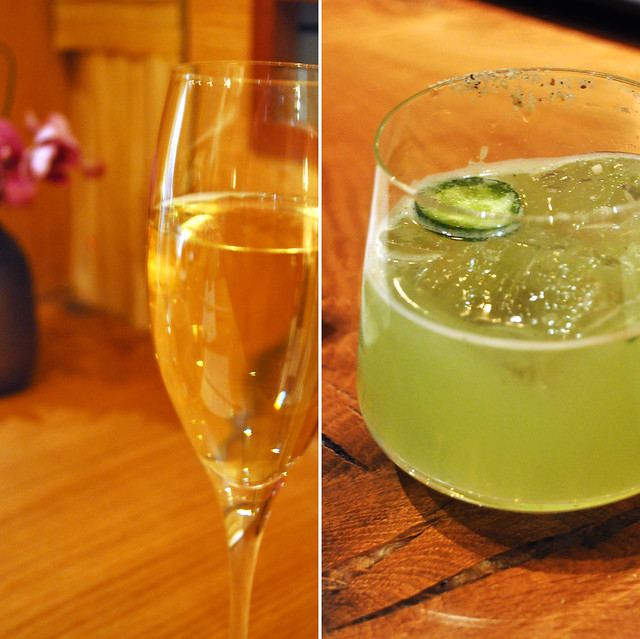
In addition to our usual cups of green tea while seated at the sushi bar, we perused the wine/sake/cocktail list. It would really be one of the only times we'd be looking at a menu at
Ichimura as all meals are chef’s choice (i.e.,
omakase) tailored to personal preferences. I had a glass of sparkling wine -- an organic
crémant
(
sans
soufre -- without sulfats) produced by
Valentin
Zusslin from Alsace,
France with no vintage -- while Lisa had the
Japanese cucumber with Almond cocktail -- Bombay Sapphire East gin with lime and roasted coarse ground almond. My
crémant
was a bit on the dryer side (not much residual sugar), but it went nicely with the pieces of sushi later on in the evening (cut through the richness, for sure). Lisa's cocktail was a delicious choice, as it was refreshing without being too "raw" tasting and the hint of almond grounds coating the rim added an interesting nuttiness to it. Definitely having that the next time I find myself at Brushstroke!

Before we made any headway with sushi or sashimi, Chef Ichimura began each of our
omakase meals with a traditional
zensai, i.e., an appetizer plate, consisting of several cold and warm bites lined up on an oblong dish. While the common belief is that sushi chefs don't do any cooking (only preparing and
pressing sushi), Chef Ichimura makes the
zensai and other cooked dishes.
{
1} Beginning from the right, we sampled a generous helping of (
a)
ankimo, i.e.,
monkfish liver, topped with freshly grated wasabi. Though Lisa is no stranger to
ankimo, it was actually my first time tasting it. It was love at first bite -- as rich as a lobe of foie gras (no wonder it is sometimes referred to as the "foie gras of the sea"), only without being overly fatty or oily, it melted like a soft and smooth paté. I cannot wait to have it again! Next came (
b)
giant clam with pickled vegetables from Kyoto. The
giant clam was favorably crunchy and snappy, and the pickled vegetables were delicate yet tasty. Then we had marinated (
c)
maitake mushrooms in plum sauce -- earthy and light.
{
2} Overlapping in both photos at the left is the (
d)
gobo, a root vegetable. Very much like a turnip texture and nutty in taste. (
e) This next item is an ingredient for which I am still trying to figure out because I couldn't catch the name from Chef Ichimura. It had a firm, hard spongy texture (almost like snappy styrofoam) and tasted very much like a dryer jellyfish. Topped with bonito flakes, these bites were really good -- the bonito flakes really brought out its otherwise blander parts. Next up we had seared (
f)
chu-toro marinated with a spicy yuzu sauce. Not a disappointment one bit -- lightly citrus and rich, savory flesh. Saving the best for last was (
g) a block of
uni -- not sure what it was made from other than sea urchin roe, but it had the consistency of miso paste or firm tofu. It was really interesting to experience, and I would say that this would be the best way to introduce newbies to uni. The taste here was less intense and certainly less briny, two aspects of the echinoderm responsible for its naysayers.
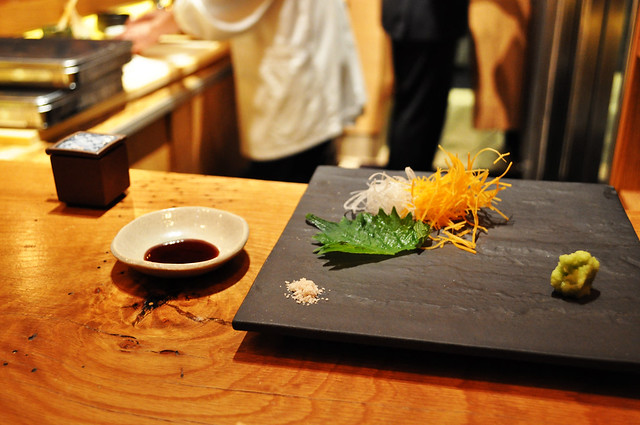
The next portion of the meal was the
sashimi omakase. We were given a granite slate platter with shredded turnip and carrots, sea salt, and freshly grated wasabi (Chef Ichimura grated a stump of wasabi root against a sharkskin paddle) along with a dish of his very own soy sauce. We had a choice of season each piece of sashimi with soy sauce OR with a sprinkle of sea salt.
Chef Ichimura "makes a compelling case against the common belief that the finest sushi is the freshest. Like a steakhouse,
Ichimura at Brushstroke dry-ages some of its best ingredients to concentrate their flavors and accentuate their sugars." Chef Bouley is also "captivated by the potential of aged fish and is already using the techniques at his flagship, Bouley, across the street."
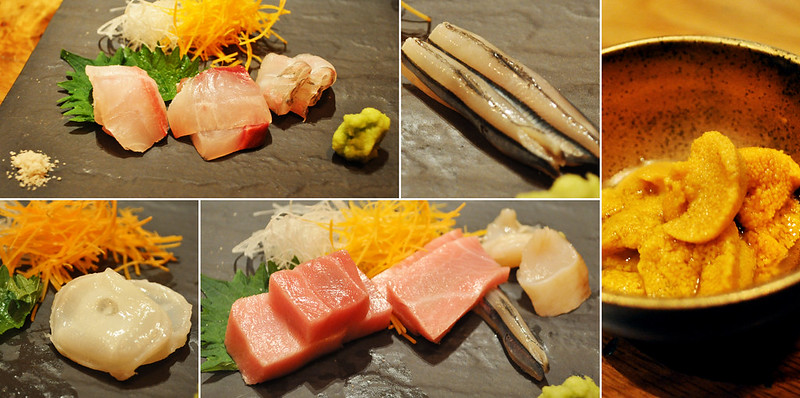
{
1} The first pieces of sashimi included (starting from the right) (
a)
hirame (fluke), (
b)
hamachi (yellowtail), and (
c)
tai (snapper). The fluke was a little too chewy for my taste and the snapper was creamy but stringy, while the yellowtail was perfect -- very soft and melty. {
2} The fourth pair was a type of (d)
anchovy, a fish I've never had raw before. It was fascinatingly fishy in a way that wasn't at all repulsive -- quite surprisingly how much flavor can be packed in these thin little things. {
5} The next few pieces included (starting from the left) (e)
chu-toro (medium fatty tuna), (f)
o-toro (fatty tuna), and (g)
mirugai (giant clam or geoduck). The two
toros were awesomely marbled with rich fat. One touch on the palate, and the fatty tuna quickly dissolved and melted away to a surprisingly savory sweetness. The
mirugai was even crunchier than the one we had sampled with the
zensai -- it was crisp, fresh, and clean. Though with a subtle taste, the geoduck is all about a delicious texture.
We had informed Chef Ichimura that we were in fact uni enthusiasts (though at this point, let's face it -- we are pretty much devotees), and boy, did he deliver! {
3} He served us a miniature, gilded bowls of the freshest
uni (sea urchin roe). They were plump, rich, buttery, and luscious -- the equivalent of echinoderm nirvana for those who live to eat these tongues. He hadn't disclosed from where these sweet, sea marigolds came, so Lisa and I speculated and rounded up our guesses. They weren't briny in the least -- a characteristic we've come to know too well when it came to identifying those from Maine. We were
so sure that these
had to be from Santa Barbara -- it was the only logical explanation. So imagine our dumbfounded expressions when he stated they were in fact from Maine. Lisa and I were blown away, concluding that
Ichimura at Brushstroke must've gotten them fresh and cracked them open in-house. It could explain the drops of natural water contained in the bowl because if they had been served from the typical trays, the lobes would be dryer. Nevertheless, the
uni at
Ichimura were hands down the best we've had from Maine. {
4} The last pieces of the
sashimi omakase was
tako (octopus), which we both found to be a little too chewy and peculiar in texture. I think I prefer the steamed/poached octopus as sashimi/sushi as opposed to raw. There seems to be more to it when prepared that way.
A brief break followed, leading into the
nigiri sushi omakase portion of the meal. Not only was each piece perfectly pressed with a dab of wasabi and a painted glaze of soy sauce (way to go, Chef Ichimura, with your disciplined paper learning technique -- it really paid off!) and remained in tact even when picking them up to be eaten by hand (per tradition and per request of the chef), the sushi rice was the real showstopper. The rice at
Ichimura is seasoned with a blend of three vinegars. I will have to agree with Mr. Wells with describing it as "unusually assertive" possibly "ruining" other sushi for us. It was utterly intoxicating, how good it all was.
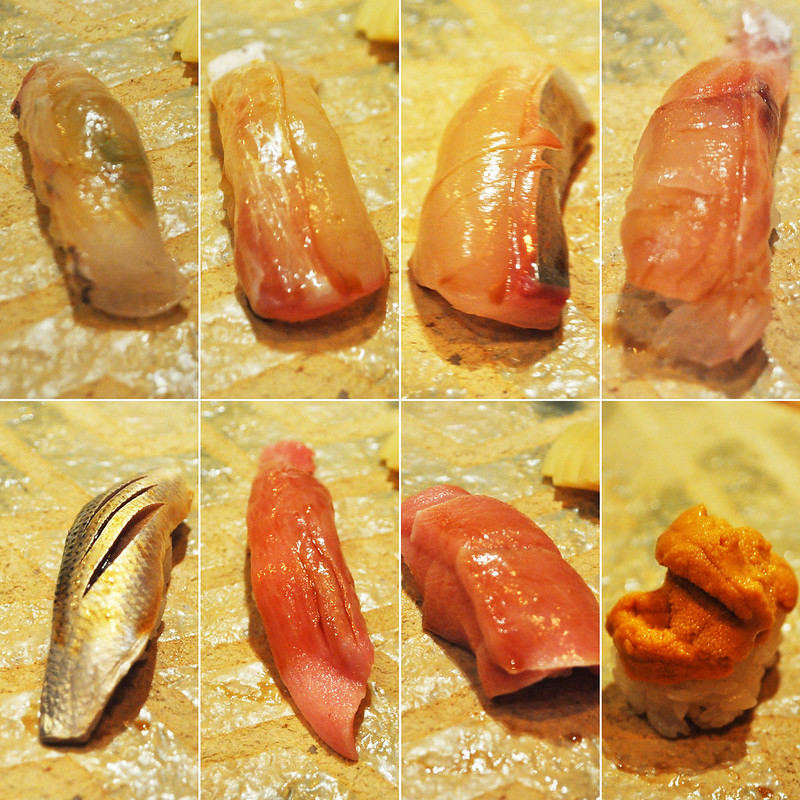
{
1} The first piece of
nigiri was
hirame (fluke), prepared by Chef Ichimura using the
kobu-jime technique of layering fish with kelp. This helps pull water from the flesh, leaving behind an umami flavor and a green color. It had an interesting taste to it, but the texture was a little too chewy for my liking. {
2} The
hamadai (red snapper belly) was great -- smooth and slipped right down. {
3} Next came the
shimaaji (striped jack) which had the ideal texture -- not at all stringy and a little tangy. {
4} A new fish to add to our repertoire was
isaki (grunt fish), which we found to be just okay -- wasn't inspiring at some of the other pieces we tried. {
5} Another "new" fish for us was one similar to a
sardine (not sure of the Japanese name). Just as with the
anchovy from the
sashimi omakase, I found the inherent fishiness of this
nigiri sushi to be enthralling -- its subdued state (probably from the
Edo-mae style of preparation) was what made it so striking. {
6,7} The
chu-toro and
o-toro were just like the ones we had earlier as
sashimi, but the rice just made it so much better. I swear Chef Ichimura has spoiled us with his magical sushi rice. Not pictured is the
mirugai (giant clam or geoduck) which was pretty good, but not as good as the
sashimi version, as it lacked that appetizing snappiness. {
8} Chef Ichimura presented some more Maine
uni for us to feast on, only now with rice. Incredibly sublime with his sushi rice. Give me an
uni donburi with
ikura roe on top of this sushi rice any day, and I will surely be a happy camper indefinitely.

The last of the
nigiri sushi omakase was the
bakagai (orange clam), which, strangely but excitingly enough, tasted like raw scallop. Lisa, who isn't very keen on scallops, did not like this at all, but I ate it all up -- so good!
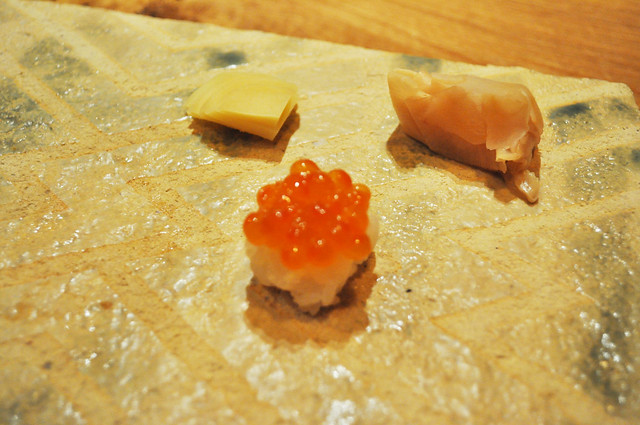
Chef Ichimura even threw in a small morsel of ikura (salmon roe) for us to try. It was quite chilly and very salty, making the orbs of brininess that much harder to burst against the palate.
Normally, Lisa and I are able to squeeze in a few more pieces of our choosing before proceeding to dessert, but the sashimi and sushi omakase at Ichimura at Brushstroke was more than enough. Our bellies, as happy as they could be, were about to burst! Also, if you may have noticed, there was no sha-ke (salmon) served to us at all -- Lisa was pretty disappointed in that regard. However, there is a more than reasonable explanation for this -- Chef Ichimura received a delivery of salmon from the restaurant's purveyor, but upon trying it, the salmon was not to his liking, therefore resulting in no salmon that evening. Talk about one fastidious sushi chef! I sincerely admire that kind of commitment to quality.
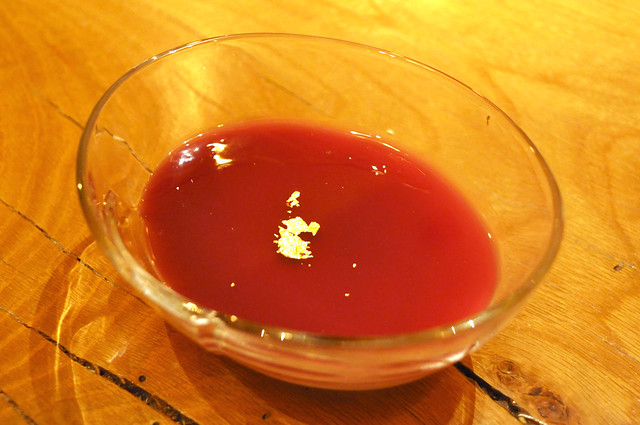
No matter how full we were, we had to share a dessert of some sort. We had our eye on the soy-milk panna cotta, a dessert that we each had on our individual visits to Brushstroke, though this time there was a grenache (red wine) coulis instead of a matcha (green tea) one. The coulis was tart yet full in intensity, complementing the smooth, milky panna cotta that could have slipped right off our spoons in one quick motion. The portion was great for us to share without overbearing our stomachs, making for a tartly sweet end to our grand dinner at Ichimura at Brushstroke.
Findings: Lisa and I spent one hell of an evening in the hands of Eiji Ichimura, one talented sushi chef, at his humble sushi bar, Ichimura at Brushstroke. I am able to finally say that I wholeheartedly stand behind Pete Wells' three-star review in The New York Times -- some serious props especially to the awesome Edo-mae style sushi and the magical tri-vinegar sushi rice. Humility and grace are the pillars of any truly successful restaurant -- after all, it's more than just a bottom line. Just as I like the company I keep, Chef Ichimura, in his soft-spoken nature, exemplifies this -- exactly what I look for in a restaurant and in the chef behind its kitchen (only in this case, a sushi bar).
So while the price point may be a little high for the average sushi eater, I think this splurge may be the wake-up call that sushi can be appreciated as a true art form once again. Tradition is the cornerstone behind Ichimura at Brushstroke, where fish are revered and taken to the ways of the Edo-mae style. If you're looking to rekindle your love for high-quality sushi in a whole new, sophisticated life, then a visit to Ichimura at Brushstroke is in the cards.
Price point: $150 per person for the sashimi and sushi omakase, $15 for each cocktail, $18 for each glass of sparkling wine, $9 for each dessert.
--November 16, 2012
Ichimura at Brushstroke
30 Hudson Street
New York, NY 10013
http://www.davidbouley.com/?page_id=1207
Ichimura at Brushstroke
30 Hudson Street
New York
NY
Incredible sushi chef who follows the Edo-mae style of sushi-making and dry-ages many of the fish selections in the same fashion steakhouses do for cuts of beef. The sushi rice is out of this world.
Four Tines and a Napkin
















